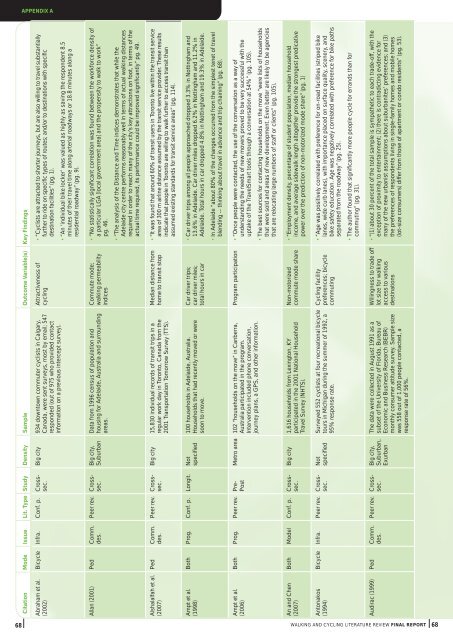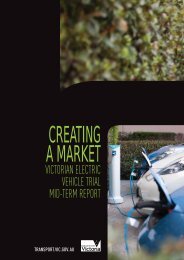Walking and Cycling International Literature Review - Department of ...
Walking and Cycling International Literature Review - Department of ...
Walking and Cycling International Literature Review - Department of ...
You also want an ePaper? Increase the reach of your titles
YUMPU automatically turns print PDFs into web optimized ePapers that Google loves.
APPENDIX A<br />
Citation Mode Issue Lit. Type Study Density Sample Outcome Variable(s) Key Findings<br />
Citation Mode Issue Lit. Type Study Density Sample Outcome Variable(s) Key Findings<br />
Abraham et al.<br />
(2002)<br />
Bicycle Infra. Conf. p. Crosssec.<br />
Big city 934 downtown commuter cyclists in Calgary,<br />
Canada, were sent surveys, most by email; 547<br />
responded (out <strong>of</strong> 975 who provided contact<br />
information on a previous intercept survey).<br />
Attractiveness <strong>of</strong><br />
cycling<br />
• “Cyclists are attracted to shorter journeys, but are also willing to travel substantially<br />
further to ride on specific types <strong>of</strong> routes; <strong>and</strong>/or to destinations with specific<br />
destination facilities” (pg. 1).<br />
• “An ‘individual bike locker’ was valued as highly as saving the respondent 8.5<br />
minutes <strong>of</strong> their travel time along arterial roadways or 18.8 minutes along a<br />
residential roadway” (pg. 9).<br />
Allan (2001) Ped Comm.<br />
des.<br />
Peer rev. Crosssec.<br />
Big city,<br />
Suburban<br />
Data from 1996 census <strong>of</strong> population <strong>and</strong><br />
housing for Adelaide, Australia <strong>and</strong> surrounding<br />
areas.<br />
Commute mode;<br />
walking permeability<br />
indices<br />
• “No statistically significant correlation was found between the workforce density <strong>of</strong><br />
a particular LGA [local government area] <strong>and</strong> the propensity to walk to work”<br />
pg. 46.<br />
• “The analysis <strong>of</strong> the Distance <strong>and</strong> Time indices demonstrates that while the<br />
Adelaide city centre performs reasonably well in terms <strong>of</strong> actual walking distances<br />
required in order to reach many <strong>of</strong> the city’s key attractions on foot, in terms <strong>of</strong> the<br />
actual time required, its performance could be improved significantly” pg. 49.<br />
Alshalalfah et al.<br />
(2007)<br />
Ped Comm.<br />
des.<br />
Peer rev. Crosssec.<br />
Big city 15,830 individual records <strong>of</strong> transit trips in a<br />
regular work day in Toronto, Canada from the<br />
2001 Transportation Tomorrow Survey (TTS).<br />
Median distance from<br />
home to transit stop<br />
• “It was found that around 60% <strong>of</strong> transit users in Toronto live within the transit service<br />
area <strong>of</strong> 300 m airline distance assumed by the transit service provider. These results<br />
indicate that people in Toronto are willing to walk further to access transit than<br />
assumed existing st<strong>and</strong>ards for transit service areas” (pg. 114).<br />
Ampt et al.<br />
(1998)<br />
Both Prog. Conf. p. Longit. Not<br />
specified<br />
100 households in Adelaide, Australia.<br />
Households that had recently moved or were<br />
soon to move.<br />
Car driver trips;<br />
car driver miles;<br />
total hours in car<br />
• Car driver trips among all people approached dropped 3.3% in Nottingham <strong>and</strong><br />
13.6% in Adelaide. Car driver miles dropped 6.2% in Nottingham <strong>and</strong> 11.2% in<br />
Adelaide. Total hours in car dropped 4.8% in Nottingham <strong>and</strong> 19.3% in Adelaide.<br />
• In Adelaide “about 80% <strong>of</strong> the changes occurred from the simplest tenet <strong>of</strong> travel<br />
blending -- thinking about travel in advance <strong>and</strong> trip chaining” (pg. 68).<br />
Ampt et al.<br />
(2006)<br />
Both Prog. Peer rev. Pre-<br />
Post<br />
Metro area 102 “households on the move” in Canberra,<br />
Australia participated in the program.<br />
Intervention included phone conversation,<br />
journey plans, a GPS, <strong>and</strong> other information.<br />
Program participation • “Once people were contacted, the use <strong>of</strong> the conversation as a way <strong>of</strong><br />
underst<strong>and</strong>ing the needs <strong>of</strong> new movers proved to be very successful with the<br />
uptake <strong>of</strong> the TravelSmart tools through a conversation at 54%” (pg. 105).<br />
• The best sources for contacting households on the move “were lists <strong>of</strong> households<br />
that were sold <strong>and</strong> areas <strong>of</strong> new development. Even better are likely to be agencies<br />
that are relocating large numbers <strong>of</strong> staff or clients” (pg. 105).<br />
An <strong>and</strong> Chen<br />
(2007)<br />
Both Model Conf. p. Crosssec.<br />
Big city 1,616 households from Lexington, KY<br />
participated in the 2001 National Household<br />
Travel Survey (NHTS).<br />
Non-motorized<br />
commute mode share<br />
• “Employment density, percentage <strong>of</strong> student population, median household<br />
income, <strong>and</strong> average sidewalk length altogether provide the strongest predicative<br />
power over the prediction <strong>of</strong> non-motorized mode share” (pg. 1)<br />
Antonakos<br />
(1994)<br />
Bicycle Infra. Peer rev. Crosssec.<br />
Not<br />
specified<br />
Surveyed 552 cyclists at four recreational bicycle<br />
tours in Michigan during the summer <strong>of</strong> 1992, a<br />
95% response rate.<br />
<strong>Cycling</strong> facility<br />
preferences; bicycle<br />
commuting<br />
• “Age was positively correlated with preference for on-road facilities (striped bike<br />
lanes, wide curb lanes), with importance placed on surface quality, scenery, <strong>and</strong><br />
bike safety education. Age was negatively correlated with preference for bike paths<br />
separated from the roadway” (pg. 25).<br />
• The author found that significantly more people cycle for err<strong>and</strong>s than for<br />
commuting” (pg. 31).<br />
Audirac (1999) Ped Comm.<br />
des.<br />
Peer rev. Crosssec.<br />
Big city,<br />
Suburban,<br />
Exurban<br />
The data were collected in August 1991 as a<br />
subset <strong>of</strong> the University <strong>of</strong> Florida, Bureau <strong>of</strong><br />
Economic <strong>and</strong> Business Research (BEBR)<br />
monthly consumer attitude survey. Sample size<br />
was 558 out <strong>of</strong> 1,000 people contacted, a<br />
response rate <strong>of</strong> 56%.<br />
Willingness to trade <strong>of</strong>f<br />
lot size for walking<br />
access to various<br />
destinations<br />
• “(1) about 30 percent <strong>of</strong> the total sample is sympathetic to each trade-<strong>of</strong>f, with the<br />
exception <strong>of</strong> proximity to entertainment; (2) there is contradicting evidence for<br />
many <strong>of</strong> the new urbanist assumptions about suburbanites’ preferences; <strong>and</strong> (3)<br />
the preferences <strong>of</strong> respondents living in single-family homes <strong>and</strong> mobile homes<br />
(lot-size consumers) differ from those <strong>of</strong> apartment or condo residents” (pg. 53).<br />
68<br />
WALKING AND CYCLING LITERATURE REVIEW FINAL REPORT 68

















